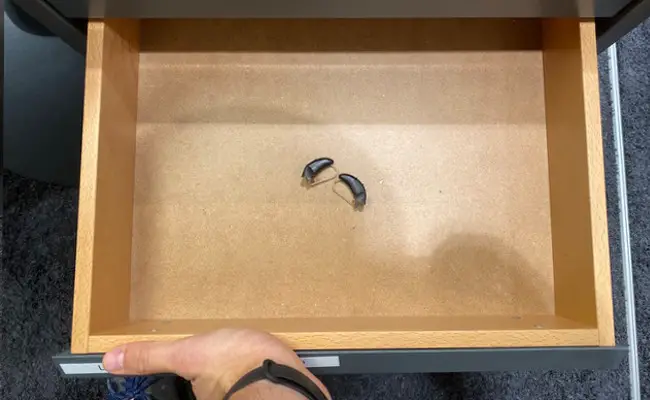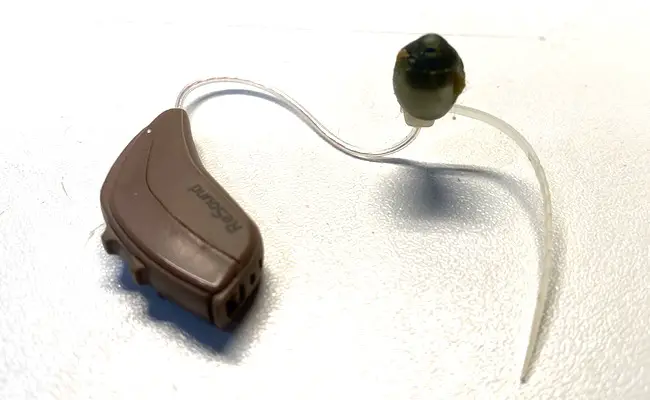In this article, you will learn about the six most common things people tell why they do not wear their hearing aids. Some of them can be solved by the acoustician.
To the detriment of the environment, the hearing aids then tend to end up in the drawer. Of course, this is also to the disadvantage of the patient with hearing loss, because the correct perception of sounds is then no longer trained correctly and a habituation to the hearing aids will never take place. Those are typical reasons.
- The hearing aid does not compensate the hearing loss
- The hearing aid hurts when wearing
- Putting the hearing aid on is too complicated
- Changing batteries or charging the hearing devices is too complicated
- Cleaning the hearing aids is not possible due to the small parts
- Sounds with the hearing aid on are perceived as too loud
- The person with the hearing loss does not want to wear the hearing aid for aesthetic reasons
- The wearer of the hearing aid does not like how their own voice sounds with the hearing aids on
- It is too complicated to operate the hearing aids
In the next paragraphs I go deeper into each of the topics of the list with suggestions that can improve the situation.

The Hearing Aid Does Not Compensate the Hearing Loss
In fact, there are many poorly fitted hearing aids. If only the minimum has been done to adjust the hearing aids, the individual fine tuning is missing. This can bring significant differences in the understanding of speech.
I have had situations where 25% speech was understood before the individual fine tuning. The exact measurements are percentile analysis or categorical loudness scaling. After the individual fine tuning, up to 100% speech was understood again.
However, it always depends on the person and the hearing loss. Even after the fine tuning, it is in rare cases that no good understanding can be present even with hearing aids. In such a case, further measurements should be taken. These will then show whether alternatives such as cochlear implants come into question.
In very rare cases, however, the auditory nerve is defective and hearing cannot be adequately compensated because the transmission of information remains disturbed.
The hearing aid can do more when the silicone piece in your ear is closed. If the wearer is not satisfied with the understanding, a closed version or a custom impression should be tried. The hearing aid fitting must then be started from the new one as the amplification can only be done in combination for one earpiece.
The Hearing Aid Hurts When Wearing
If the hearing aid hurts, the hearing care professional has many options for making modifications. Sometimes there is a pull on the ear. Then a speaker with a longer cable can be chosen or a longer tube that connects the hearing aid to the earpiece.
If the earpiece itself hurts then this can of course be modified. The hearing care professional will rework the earmold. There is also the possibility that the earmold once fit but now pinches. Talk to your hearing care professional about the problem and he will be happy to help you.
Putting the Hearing Aid on Is Too Complicated
It becomes especially difficult when it is too complicated to insert the hearing aids due to motoric limitations. For many younger people it is not understandable when visiting a relative and the hearing aid is not worn again.
However, this is a more complicated task for many older people. As I myself work in the store every day fitting hearing aids, I can see the problems with inserting them. Usually, there is a daily that fits a person individually. However, the fitting technique can be extremely different from person to person.
My recommendation is always to meet with a drink in peace and practice together. It is then practiced until the person can use the hearing aid. I have spent many appointments doing this. The important thing is to break off and make another appointment before the person gets frustrated.
Changing Batteries or Charging the Hearing Devices Is Too Complicated
In some cases, family members or caregivers are in high demand. In some cases, movements and memory are so limited that changing batteries or charging hearing aids is no longer possible. In many situations, however, some improvement can be made.
If I see that the hearing aid user has severe problems with inserting batteries I offer other hearing aids with a larger battery that is easier to change. If a smaller battery with size 312 does not work the two larger options 13 and 675 should be tried.
The situation is similar for charging stations. There are differences when putting in and taking out the hearing aids. Some charge using contacts that need to be hit correctly. Other charging stations charge inductively and offer the advantage that the hearing aid only has to be placed in a certain area to initiate the charging process.
It is important that once problems occur, they are addressed very carefully. This means that the hearing care professional must look closely at how the hearing aids are placed in the charging cradle by the client. Sometimes the angle of insertion is not correct or the devices do not click into place. In such a case, a different hearing aid with a different charging cradle is often a good alternative. Also, ask if there is another charging cradle for the same hearing aid.
Cleaning the Hearing Aids Is Not Possible Due to the Small Parts
Hearing aids have a lot of small parts that need to be cleaned daily. If this does not happen, the function of the hearing aids will be limited over time. When cleaning can no longer be done by the hearing aid user, it should be done by family members. If there is no possibility to clean the hearing aids, the hearing care professional should be visited more often.
It may well be that cleaning appointments should be made every 2-4 weeks. These should be arranged individually since some people form more earwax than others.

Sounds With the Hearing Aid on Are Perceived as Too Loud
If sounds are perceived as too loud, it is often not necessarily because the hearing aid is too loud, but because the user is not used to the volume. There are sounds like the running water from the faucet or the toilet flushing that are quite loud but are perceived much quieter by a person with hearing loss.
There is a lot of need for explanation here in the first place. Because many people think they know how certain sounds must sound although there are many studies that show that our memory around sounds only works well for a few seconds.
If you turn the hearing aid down, understanding often suffers. I always try to demonstrate this with a practical example by measuring speech understanding in the old and new settings. I can then easily and quickly demonstrate the result to the hearing aid user. Many then prefer a louder setting and then have better speech understanding.
The wrong way is to explain nothing and just turn the hearing aid down. This is because the hearing aid user will find the quieter hearing aid more comfortable. However, more comfortable also means that speech understanding will be worse.
The Person With the Hearing Loss Does Not Want to Wear the Hearing Aid for Aesthetic Reasons
The look is very important for many people. For this reason, it is understandable that hearing aids do not necessarily rejuvenate self-perception. However, nowadays there are such small devices that are no bigger than a coffee bean. In fact, they are only a few millimeters.
It is also possible for 90% of people to have the hearing aid disappear completely into the ear. That way, no one sees it. So today, aesthetic reasons no longer have to speak against a hearing aid. These small devices are also often available in lower price ranges.
The Wearer of the Hearing Aids Does Not Like How Their Own Voice Sounds With the Hearing Aids On
Whenever a hearing aid is placed in the ears, one’s own voice can seem more or less altered. There are ways to change this.
First and foremost, the hearing care professional should know which parts of the earpiece to mill off in order to make your voice sound more natural again.
The shape of the earpiece plays the most important role. However, hearing aid manufacturers also offer features to counteract the change in some voices. For example, Signia changes the amplification when you speak (not with all devices) to make your voice sound more natural.
This feature is called own voice processing.
It Is Too Complicated to Operate the Hearing Aids
There are hearing aid users who actually forget how to use the hearing aids all the time. Here it is important not to lose motivation. Above all, the environment of the hearing aid user is addressed here. He should always be encouraged to wear the hearing aids.
In such a case, the hearing care professional should choose a setting that covers as many areas of the hearing aid user’s life as possible. This way it is not necessary to adjust the hearing aid often. If the hearing aid itself cannot be operated, a remote control may be appropriate. These often have large symbols and are easier to use than the small buttons on the hearing aids.
